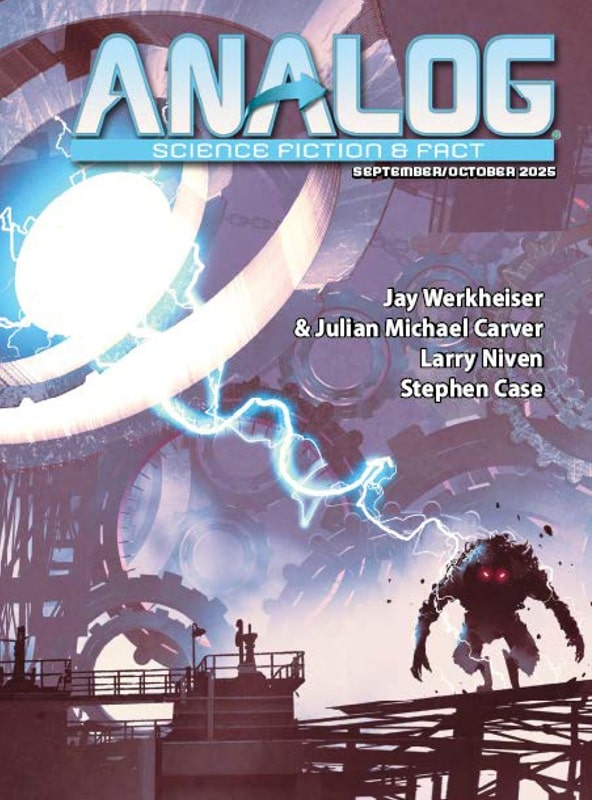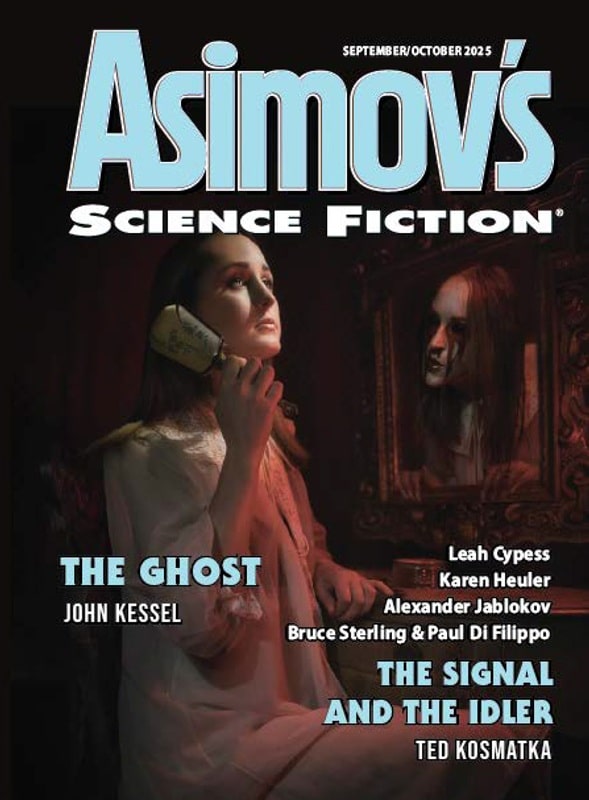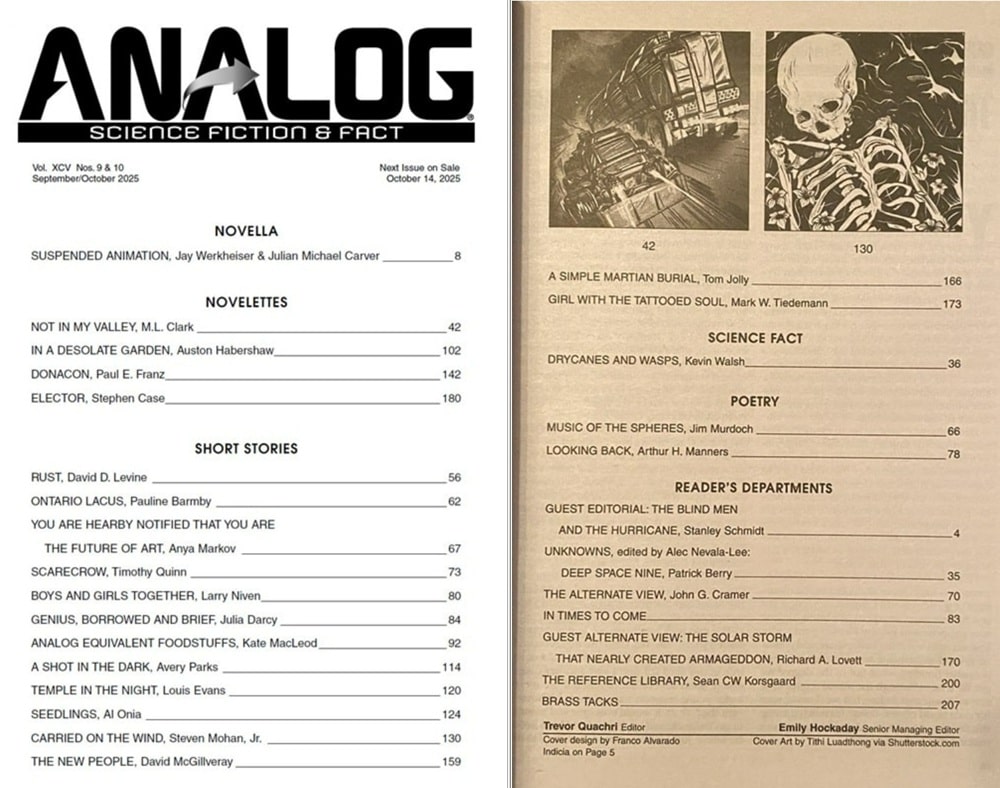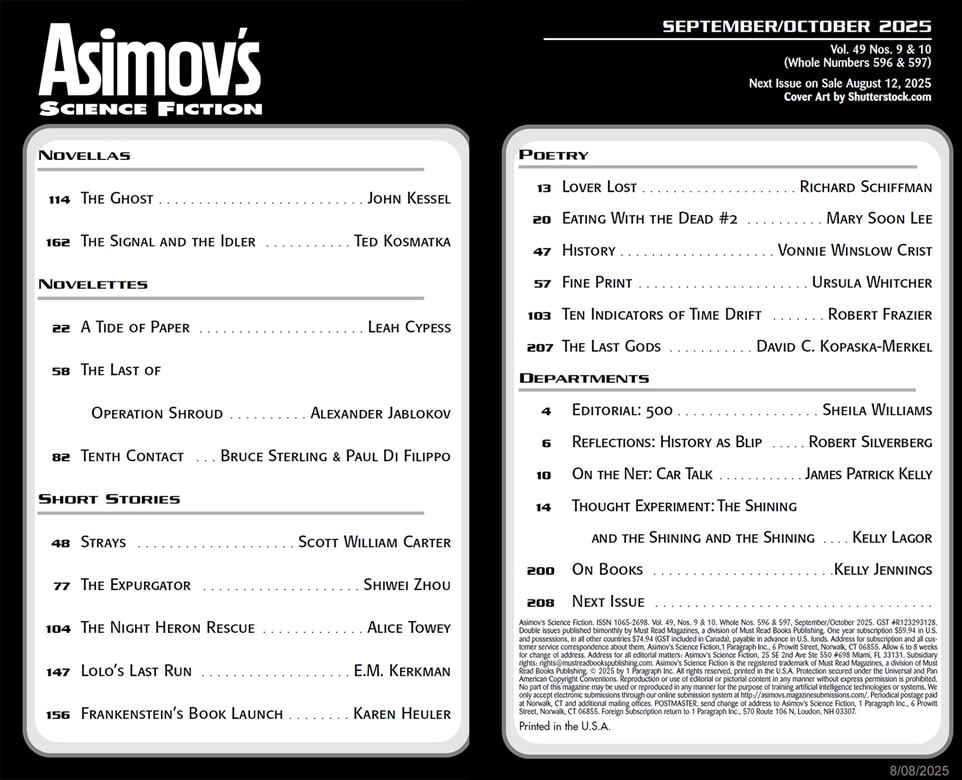Stray Missiles, Alien Plagues, & Underwater Laboratories: September-October Print Science Fiction Magazines
 |
 |
September-October 2025 issues of Analog Science Fiction & Fact and
Asimov’s Science Fiction. Cover art by Tithi Luadthong/Shutterstock
It’s the 500th issue of Asimov’s Science Fiction! That explains why I had to start stacking them sideways in 2004. Sheila Williams celebrates this incredible milestone in her editorial, touching on just a sampling of the truly extraordinary fiction to appear in the magazine over the past 48 years. Here’s an excerpt.
Under our first editor, George H. Scithers, we published great tales by writers like Barry Longyear, Roger Zelazny, and Somtow Sucharitkul. Kathleen Moloney’s tenure lasted less than a year, but during that time we published Connie Willis’s earliest award-winning stories — “A Letter from the Cleary’s” and “Fire Watch,” as well as David Brin’s “The Postman.” Important work published by Shawna include Octavia Butler’s “Blood Child,” Greg Bear’s “Hardfought,” George R.R. Martin’s “Portraits of his Children,” Kim Stanley Robinson’s “Green Mars,” and Robert Silverberg’s “Sailing to Byzantium.”
Gardner Dozois’s years at the helm brought us James Patrick Kelly’s “Think Like a Dinosaur,” Pat Murphy’s “Rachel in Love,” Neal Barrett, Jr.’s “Ginny Sweethips’ Flying Circus,” Terry Bisson’s “Bears Discover Fire,” Allen M. Steele’s “The Death of Captain Future,” Michael Swanwick’s “Scherzo with Tyrannosaur,” Charles Stross’s “Lobsters,” and much more.
Among the stories I’m most proud to have published are Kij Johnson’s “26 Monkeys, Also the Abyss,” Alaya Dawn Johnson’s “They Shall Salt the Sea with Seeds of Glass,” Robert Reed’s “Murder Born,” Greg Egan’s “The Four Thousand, the Eight Hundred,” Kristine Kathryn Rusch’s “Recovering Apollo 8,” Nancy Kress’s “Fountain of Age,” and Daryl Gregory’s “Second Person, Present Tense.” I’m also pleased to have discovered authors like Ray Nayler, Gregory Norman Bossert, and Dominica Phetteplace.
Read the whole thing here.
Still no new issue of Fantasy & Science Fiction this month, but I’m hopeful we’ll see something before the end of the year. In the meantime, the September/October issues of Analog and Asimov’s SF are more than enough to tide us over, with contributions from John Kessel, Ted Kosmatka, Alexander Jablokov, Bruce Sterling and Paul Di Filippo, Scott William Carter, Alice Towey, Karen Heuler, Stephen Case, David D. Levine, Larry Niven, Kate Macleod, Steven Mohan, Jr., Mark W. Tiedemann, and many more.
Victoria Silverwolf at Tangent Online has some thoughts on the latest Analog.
“Suspended Animation” by Jay Werkheiser and Julian Michael Carver is this issue’s sole novella. After part of an asteroid lands in Alaska, an expert in cinematic imaging and special effects is assigned to aid scientists and the military with studying the microscopic lifeform that arrived with it. The organism’s peculiar biology threatens Earth’s ecosystem. In the tradition of biological thrillers such as Michael Crichton’s 1969 novel The Andromeda Strain, this story features a race against the clock to find a way to neutralize the menace…
The narrator of “Rust” by David D. Levine is one of a group of chimpanzees with increased intelligence who have managed to survive in an underwater laboratory for several years. Two people in a small submarine arrive to decommission the facility, unaware of its living inhabitants. Their disagreement about what should be done leads to a crisis…
In “Genius, Borrowed and Brief” by Julia Darcey, a student of digital art discovers strange images appearing on his computer each night. He claims the works as his own, leading to great success. The mysterious images exert a powerful effect on human emotions, leading to a dramatic climax. The source of the images is never fully explained, although the implication is that they are the products of an inhuman intelligence. The result is a story that reads like cosmic horror…
The main characters in “In a Desolate Garden” by Auston Haberhsaw are fully sentient copies of the minds of an extremely rich man and his wife. They are sent on a probe to a planet that can be terraformed into a private paradise for the couple. When this is completed, the real people will travel to the world in suspended animation. Complications ensue when another consciousness contacts them… This novelette is quite ambitious, and it succeeds.
The title of “Temple in the Night” by Louis Evans refers to a gigantic alien object that cannot be detected in any normal way, but which appears in the minds of starship pilots during the trances that allow them to travel interstellar distances. A commander dismisses the thing as a myth, but a rebellious pilot sets out for it…
The novelette “Elector” by Stephen Case takes place in the extreme far future, with a large number of planets settled by human beings. Each one contains an artificial intelligence the size of a mountain, with which the planetary authority consults. The plot deals with one such authority, who is to take part in electing the person who will join with the central ruling AI in a form of symbiosis. For reasons not yet known, the election is being held years earlier than expected… There is much more to this story than I have indicated in this synopsis. The work is complex enough for a novella or even a novel. Numerous speculative concepts give the background an exotic flavor without sacrificing clarity. The author creates a true sense of wonder while offering richly developed characters.
Read Victoria’s complete review here.
The new Asimov’s is reviewed by Sam Tomaino at SFRevu. Here’s an excerpt.
The fiction begins with the novelette, “A Tide of Paper” by Leah Cyress.
Samuel and Joseph are Jews living secretly in Venice with their Aunt Beatrice, also a secret Jew. They go to a print shop run by a Jew who prints Jewish manuscripts and find him murdered. Samuel can see ghosts and sees the ghost of the murdered man whispering, “Help her…” We get a look at the lives of these people and the politics of living in secret. Great story which really takes you back to that time.
“Strays” by Scott William Carter
Desmond and Nettie are a husband and wife team whose job it is to destroy stray missiles from a war. They have traveled far, even in cryogenic sleep, for many years to do this. But on the latest missile they’ve found, there are signs of some sort of life. Nettie wants to rescue them, but Desmond says that is impossible. How will this be resolved? Beautiful, bittersweet tale.
“The Last of Operation Shroud” by Alexander Jablokov
Alma has returned to the planet she had fought on with the rest of her squad repelling an alien invasion. They were assigned to destroy a ship called the Lurkig which had been concealed by a device called the Shroud. She could not remember how things had ended or even the names of the rest of her squad. She has a way to find out where the Shroud and the Lurkig had been. With the help of the local people, she finds what she was looking for. But at a price. Another, well-told bittersweet tale.
“Tenth Contact” by Bruce Sterling & Paul Di Filippo
Harpone (sharp-eyed prospector), Audax (scholar-analyst), and Consilience (engineer-director) are the Tenth Contact crew on Ganymede. They have contact with some native creatures, but a “galactic storm” causes chaos even on Earth. They have to decide how best to protect the native creatures of Ganymede, and they make their decision. Another good story.
“Lolo’s Last Run” by E.M. Kerkman
Our narrator is part of the Spirit Rescue Service. He is a spirit who can rescue people by possessing them. His latest rescue fell into a crevasse with his sled and dogs. He got impaled and is dead, and that makes rescue easier. He can just possess the dead body. But there is a complication; the lead dog is still alive… Another nicely done story.
“Frankenstein’s Book Launch” by Karen Heuler
The Famous Monster has written a book telling his story, and he is making a personal appearance at a bookstore. The story is done in a serious way and the monster says the doctor is the real monster. Perfect ending, too!
Another great issue of Asimov’s! Subscribe!
Read Sam’s full review here.
Here’s all the details on the latest SF print mags.

Analog Science Fiction & Science Fact
Editor Trevor Quachri gives us a tantalizing summary of the current issue online, as usual.
When even the combined resources of the federal government can’t find a way to communicate with as alien a life-form as it gets, just what can a lone Hollywood visual effects specialist bring to the table? More than you might think! Find out exactly what (and how!) in this issue’s novella, “Suspended Animation,” from Jay Werkheiser and Julian Michael Carver.
Our fact article, “Drycanes and WASPs” from Kevin Walsh, looks at violent weather — specifically hurricane-, tornado-, and blizzard-equivalents — on other planets, both real and fictional.
And of course there are plenty of other stories, including a white-knuckle duel on an alien moon in “Not in my Valley,” by M.L. Clark; the unraveling of a grand galactic conspiracy in “Elector” by Stephen Case; a fitness breakthrough revealing some ugly bits of business and human nature in “Donacon,” by Paul E. Franz; a short return to a familiar setting from Larry Niven in “Boys and Girls Together”; plus plenty more, including a few seasonally-appropriate bits and bobs, as well as all our regular features and columns.
Don’t miss it!
Here’s the full TOC.
Novella
“Suspended Animation,” Jay Werkheiser & Julian Michael Carver
Novelettes
“Not In My Valley,” M.l. Clark
“In a Desolate Garden,” Auston Habershaw
“Donacon,” Paul E. Franz
“Elector,” Stephen Case
Short Stories
“Rust,” David D. Levine
“Ontario Lacus,” Pauline Barmby
“You are Hearby Notified That You Are the Future of Art,” Anya Markov
“Scarecrow,” Timothy Quinn
“Boys and Girls Together,” Larry Niven
“Genius, Borrowed And Brief,” Julia Darcy
“Analog Equivalent Foodstuffs,” Kate Macleod
“A Shot in the Dark,” Avery Parks
“Temple in the Night,” Louis Evans
“Seedlings,” Al Onia
“Carried on the Wind,” Steven Mohan, Jr.
“The New People,” David Mcgillveray
“A Simple Martian Burial,” Tom Jolly
“Girl with the Tattooed Soul,” Mark W. Tiedemann
Science Fact
Drycanes and Wasps, Kevin Walsh
Poetry
Music of the Spheres, Jim Murdoch
Looking Back, Arthur H. Manners
Reader’s Departments
Guest Editorial: The Blind Men and the Hurricane, Stanley Schmidt
The Alternate View, John G. Cramer
In Times to Come
Guest Alternate View: The Solar Storm That Nearly Created Armageddon, Richard A. Lovett
The Reference Library, Sean CW Korsgaard
Brass Tacks

Asimov’s Science Fiction
Sheila Williams provides a brief summary of the latest issue of Asimov’s at the website.
Stories by Mark W. Tiedemann, M.L. Clark, Stephen Case, Auston Habershaw, David D. Levine, Pauline Barmby, Larry Niven, Kate MacLeod, and many others!
You’ll find our September/October 2025 issue on sale at newsstands on August 10, 2025. Or subscribe to Asimov’s — in paper format or our own downloadable varieties — by visiting us online at www.asimovs.com. We’re also available individually or by subscription via Amazon.com’s Kindle Unlimited, BarnesandNoble.com’s Nook, and Magzter.com/magazines!
Here’s the complete Table of Contents.
Novellas
“The Ghost” by John Kessel
“The Signal and the Idler” by Ted Kosmatka
Novelettes
“A Tide of Paper” by Leah Cypess
“The Last of Operation Shroud” by Alexander Jablokov
“Tenth Contact” by Bruce Sterling and Paul Di Filippo
Short Stories
“Strays by Scott” by William Carter
“The Expurgator” by Shiwei Zhou
“The Night Heron Rescue” by Alice Towey
“Lolo’s Last Run” by E.M. Kerkman
“Frankenstein’s Book Launch” by Karen Heuler
Poetry
Lover Lost by Richard Schiffman
Eating With the Dead #2 by Mary Soon Lee
History by Vonnie Winslow Crist
Fine Print by Ursula Whitcher
Ten Indicators of Time Drift by Robert Frazier
The Last Gods by David C. Kopaska-Merkel
Departments
Editorial: 500 by Sheila Williams
Reflections: History as Blip by Robert Silverberg
On the Net: Car Talk by James Patrick Kelly
Thought Experiment: The Shining and the Shining and the Shining by Kelly Lagor
On Books by Kelly Jennings
Next Issue
Analog, Asimov’s Science Fiction and The Magazine of Fantasy & Science Fiction are available wherever magazines are sold, and at various online outlets. Buy single issues and subscriptions at the links below.
Asimov’s Science Fiction (208 pages, $9.99 per issue, one year sub $57.75 in the US) — edited by Sheila Williams
Analog Science Fiction and Fact (208 pages, $9.99 per issue, one year sub $57.75 in the US) — edited by Trevor Quachri
The Magazine of Fantasy & Science Fiction (256 pages, $10.99 per issue, one year sub $65.94 in the US) — edited by Sheree Renée Thomas
The September-October issues of Asimov’s and Analog are officially on sale until November 3, but given the bumpy nationwide distribution recently, may well be on shelves a little longer than that. See our coverage of the July-August issues here, and all our recent magazine coverage here.
“In the meantime, the September/October issues of Analog and Asimov’s SF are more than enough to tide us over…”
No, they aren’t. Those two magazines should be shelved next to many more genre magazines – Science Fiction Age, Galaxy Science Fiction, If, Science Fiction Monthly, Galileo….
Steve,
You won’t get an argument from me.
I’m glad you mentioned Charles C. Ryan’s Galileo magazine, which only lasted 16 issues between 1976-1980, but which still looms large in my imagination. It was one of the very few large-size SF magazines on the stands at the time (the others included Starlog, and the short-lived Isaac Asimov’s Science Fiction Adventure Magazine), and I remember its gloriously colorful covers very fondly.